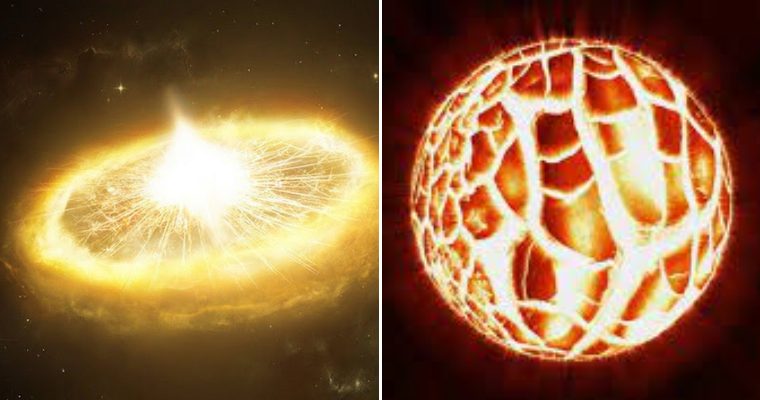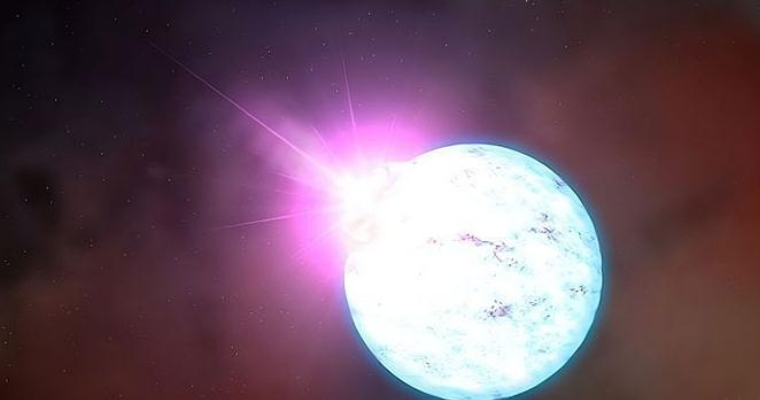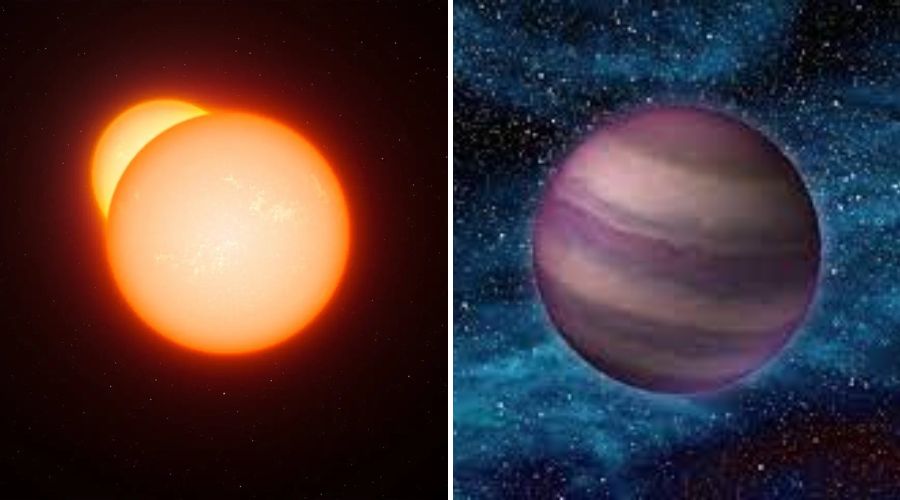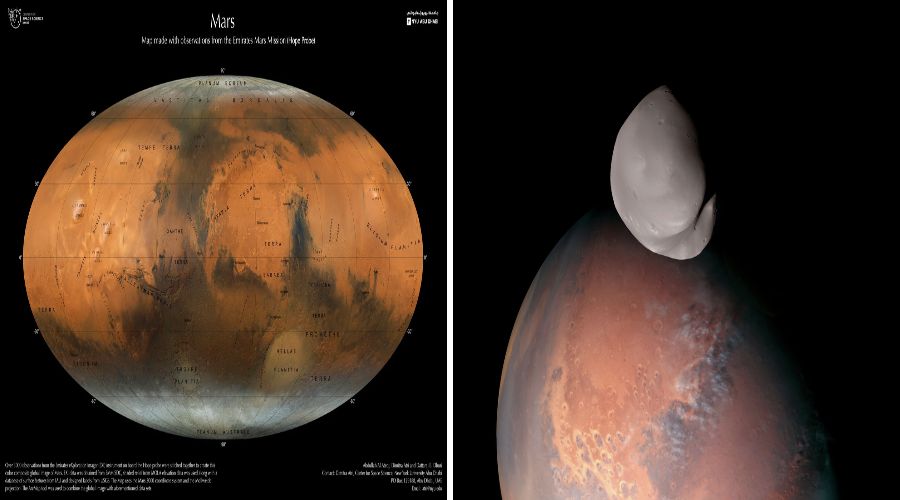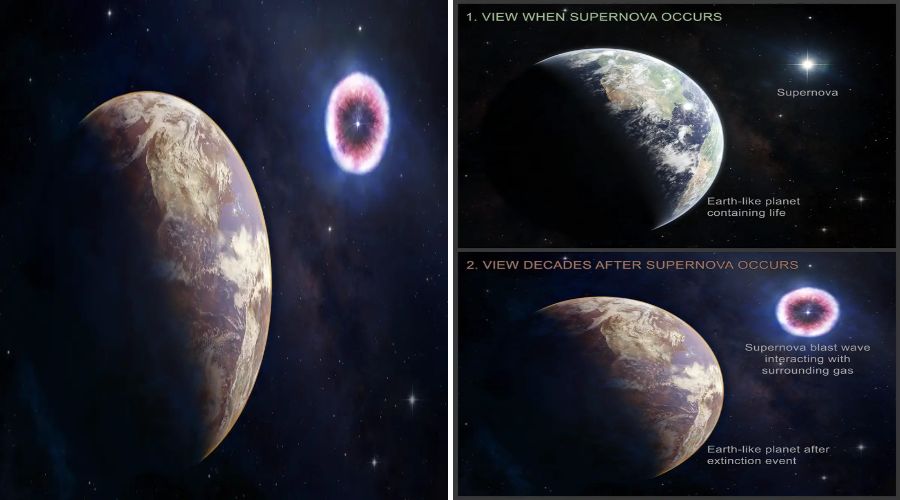How much larger is the sun compared to the Earth?
The comments on many Popular Science sites are surprising, because so many people take illustrations like this seriously, but neither the proportions nor the distances of them are even close to reality.
In fact, the Sun and the Earth, when placed next to each other, would look like this: the diameter of the earth is 12 742 kilometers and that of the sun is one million three hundred ninety two thousand seven hundred kilometers.
That is, there would be enough space from one side of the Sun to the other to accommodate 109 Earths with a little more room left over.
That’s already pretty impressive, but it’s still not entirely obvious just how huge the sun really is.

It’s clearer if you look at the circumference.
The Earth has an equatorial circumference of 40 075 kilometers.
Let’s take the cruising speed of an ordinary passenger airplane: 800 kilometers per hour.
A simple calculation shows that it would take almost exactly 50 hours of continuous flight without Landing to fly around the earth’s equator.
That’s roughly two days.
Now fasten your seat belts.
We are going to fly the same imaginary airliner, but around the Sun.
The circumference of our star is four million 379 000 kilometers and our plane would need about 5473 hours, 228 days, that’s over 32 weeks, about eight months.
If we start talking about volume, the figures are going to be astronomical in every sense.
The sun’s volume is 1.412 to the 10th power of 18 cubic kilometers.
Here’s what this figure looks like, and here is the Earth’s volume, also in cubic kilometers.
Our imagination starts to falter at these numbers.
Zeros flicker before our eyes
And we can’t quite grasp the difference.
So here is a clear demonstration.
If we neglect The Voice between these fears, about 1.3 million Earth planets would fit into the sun.
We’ll give you a few seconds to realize that, although this realization is quite invigorating, it’s all just a warm-up saw.
Despite its hugeness, is a pretty ordinary star.
There are stars bigger than the Sun and everyone who’s even slightly familiar with the subject knows that.

But not everyone can even imagine to what extent other stars can be bigger than the Sun.
There are giants, there are super Giants and then there are hyper Giants.
KY Sydney
Let’s focus on them, the hypergiants, giant Stars meet the first one, the star Ky, Sydney.
Whereas the sun can accommodate 109 Earth planets from edge to edge, this monster can easily hold as many as one thousand, not Earths, but Sons.
This monster lives near the bright, scattered star cluster, Ngc 6913, about 5 000 light years away from us.
The star has a Luminosity ranging between 138 000 and 270 000 Suns, according to various estimates, but the star is not visible to the naked eye because of the effect of interstellar Extinction.
The surface temperature is also much lower than that of the sun- 3550
Kelvin, which also reduces the visibility through clouds of space dust.
Stars like Ky Sydney are quite difficult in terms of determining their properties and even their exact size.
It’s all a combination of interference factors, distance, Interstellar Extinction effects and close proximity to other stars.
In addition, such Giants can be pulsating, in which case there is a very noticeable change in the size of the star over the course of one or two Earth years.
Ky Sydney is even more complicated.

It is a variable star with large amplitude, but even without a clear periodicity.
At times it changes in size rather quickly, while at other times it is fairly constant over a long period of time.
All this complicates the analysis and therefore there is still no consensus about the exact size of the Ky signee.

But one thing most scientists agree on is that it is one of the smallest hypergiants.
Yes, this star is even sometimes referred to as a boundary star.
An object with less Luminosity would no longer be considered a hypergiant, but there are stars whose hyper gigantism no one doubts, and discussions are held only about the exact size and properties.

For a long time, this star has been the Undisputed leader in terms of proven size, and even now, after most scientists have demoted it to at least second place, it remains incredibly interesting.
VY Canis Majoris
This is v y Canis Majoris, located at a distance of about 3800 to 5 000 light years away from Earth in the constellation of the same name.
There is no unequivocal opinion about its size, as in the case of the Ky sickney, but most stick to an estimate of 1420 Sun Radii.
It is so enormous that, if placed in the position of our star, it would reach the orbit of Jupiter.
Interestingly, with such a mind-blowing size, the mass of Vy Canis Majoris is estimated to be 15 to 25 times the mass of the sun.
No, not 15 to 25 million times, not even thousands of times, but just 15 to 25 times.
This may seem unbelievable and even ridiculous, but it is true, and here’s why.
Vy Canis Majoris has an average density of 5.33 to 8.38 milligrams per cubic meter.
That doesn’t tell you anything, does it?
Okay

Then how about this?
The density of the Earth’s atmosphere at sea level is about 1.2 kilograms per cubic meter.
Again, the average density of matter of the hypergiant star v Y Canis Majoris is about 100 000 times less than the density of the air on Earth’s surface.
As strange and even absurd as it may seem, it is a normal thing for hyper giant stars, as especially the ones living out their age, and that’s exactly what VY Canis Majoris is.
Astronomers believe that it is actually beginning to die, although in terms of astronomical standards, it has lived very little, about 10 million years.
For comparison, our sun has already lived 4.5 billion years and it still has a long time to live, but Vy Canis Majoris has, according to rough estimates, no more than 100 000 years left.
Scientists suggest that the star has already dropped more than half of its mass.
In 2021, the Hubble Space Telescope observed the star spitting out large threats of hot gas, which coincided with changes in its luminosity, and this process will continue to increase.
No one can give an exact prediction about the future evolution a v Y Canis Majoris, yet it may follow the scenario of transformation into a yellow hypergiant and then into the so-called wolf Riot star.

This is an even rarer type of massive stars, which are in the late stages of evolution and have already lost almost the entire hydrogen envelope.
But they’re still rich in helium and it’s what they burn in their core in thermonuclear reactions.
Anyway, the end of Vy Canis Majoris will be rather unambiguous.
Like all supergiants, the star is almost certain to explode as a supernova or even a Hypernova.
It has already begun to massively fuse helium into carbon and will continue to synthesize heavier and heavier elements up to iron.
At the same time, like the famous Beetlejuice, it is losing its mass and will presumably explode within the next 100 000 years.
The explosion will probably cause deadly gamma-ray bursts and the shock wave will sweep at several thousand kilometers per second, demolishing everything on its path in near space.
It will keep terrorizing the far reaches with radiation for many years until it loses its power due to dissipation.
Most probably, there will be not even a neutron star, but a black hole at the place of the star.
If there are still sentient observers on Earth by then, they will be able to enjoy an unforgettable show.
The fireworks will probably be visible even in the daytime
Stevenson 22208
And now, finally, we move from the former leader to the current champion.
Stevenson 2-1-8 is a bright red hypergiant in the Stevenson two-star cluster in the constellation Scutum.

This star is much farther away from us than the previous two, eighteen thousand nine hundred ten light years away.
That said, it’s even slightly better studied, although there are still discussions about its size.
And even the most realistic figure looks absolutely exorbitant: two thousand one hundred fifty Sun Radii.
Put in the place of our sun, the star Stevenson 2-1-8 would absorb Mercury, Venus, Earth, Mars and even Jupiter and would reach the orbit of Saturn with its Photosphere, basically its surface, with such Dimensions.
Even as a cold red supergiant, Stevenson 2-1-8 has luminosity 437 000 times greater than that of our sun.
The volume of the star is about 10 billion times the volume of the sun.
Just recall the beginning of the video where the sun accommodated 1.3 million planets Earth, and imagine 10 billions of suns.

That’s just a whopping, unimaginable volume.
Yet with this difference in volume, Stevenson 2-1 8 is only 50 times heavier than the sun.
Its matter is also very, very rarefied- hundreds of thousands of times rarer than earth’s air, and Stevenson 2-1-8 has the same density as all hypergiants.
They only form in the largest and densest regions of star formation, where there is literally an abundance of materials for new stars.
That’s why they are so huge and that’s why they live so little and die so brightly.
We are lucky with our son.
It was born far away from such zones and that’s really fortunate.
Areas of star formation are like a real furnace, a Melting Pot, a forge.
It’s almost impossible for earth-type life to originate there.
Our son was born in a quiet harbor with perfect conditions for the Cradle of life, away from all those space monsters.
We’d rather watch them from afar, foreign.



